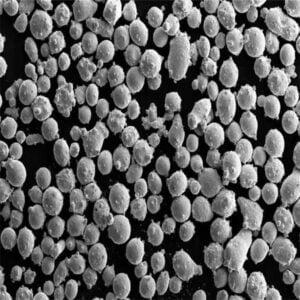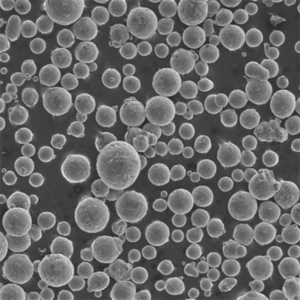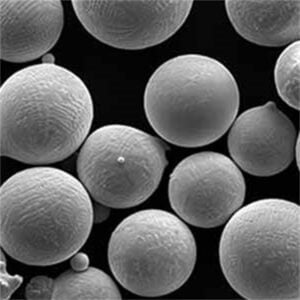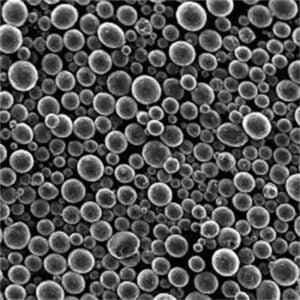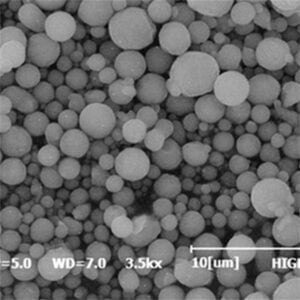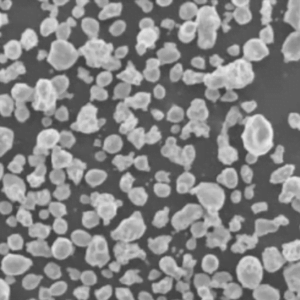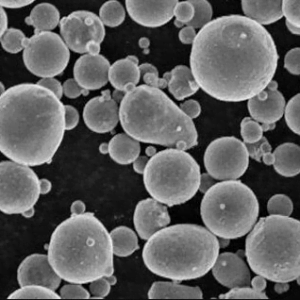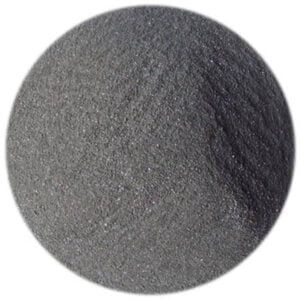2024년 스테인리스 스틸 17-4PH 파우더
목차
개요
스테인리스강 17-4PH 분말은 금속 3D 프린팅에 사용할 수 있는 침전 경화 마르텐사이트계 스테인리스강입니다. 강도와 경도가 높고 내식성이 우수합니다. 17-4PH에는 약 4%의 구리가 함유되어 있어 구리가 풍부한 입자의 침전을 통해 합금의 시효 경화를 가능하게 합니다.
이 문서에서는 17-4PH 분말의 구성, 특성, 가공, 용도, 공급업체, 다른 합금과의 비교 등 17-4PH 분말에 대한 개요를 제공합니다. 주요 세부 사항은 아래 표에 요약되어 있습니다.
17-4PH 파우더 구성
17-4PH는 약 4% 구리를 포함하는 성분에서 그 이름을 따왔습니다. 주요 합금 원소는 다음과 같습니다:
| 요소 | 무게 % |
|---|---|
| 크롬 | 15 – 17.5% |
| 니켈 | 3 – 5% |
| 구리 | 3 – 5% |
| 망간 | ≤ 1% |
| 실리콘 | ≤ 1% |
| 탄소 | ≤ 0.07% |
| 유황 및 인 | ≤ 0.04% |
| 질소 | ≤ 0.03% |
구리 성분은 침전물 경화를 일으켜 17-4PH의 강도와 경도를 크게 증가시킵니다. 크롬은 내식성을 제공합니다. 니켈 또한 내식성을 높이는 동시에 연성과 인성을 향상시킵니다.
17-4PH 파우더 속성
17-4PH 파우더는 고강도와 우수한 내식성의 탁월한 조합을 제공합니다. 주요 특성은 다음과 같습니다:
| 속성 | 설명 |
|---|---|
| 힘 | 인장 강도 최대 1,380MPa, 항복 강도 최대 1,240MPa |
| 경도 | 노화 후 최대 44 HRC |
| 내식성 | 구리로 인해 400 시리즈 스테인리스강보다 우수합니다. |
| 가공성 | 강도가 높아 300 시리즈보다 기계 가공이 더 어렵습니다. |
| 자성 | 마르텐사이트 미세 구조로 인해 약간의 자성이 있습니다. |
| 용접성 | 침전물 경화로 인해 300 시리즈보다 용접성이 낮음 |
열처리를 통해 강도, 경도 및 내식성을 조정할 수 있습니다. 용액 어닐링은 합금을 부드럽고 연성화합니다. 이후 노화는 구리가 풍부한 입자의 침전을 유도하여 전위 이동을 방해함으로써 소재를 경화 및 강화합니다.
17-4PH 처리
17-4PH 파우더는 여러 금속 3D 프린팅 방법을 통해 가공할 수 있습니다:
- 레이저 파우더 베드 퓨전(L-PBF)
- 전자빔 파우더 베드 융합(E-PBF)
- 직접 에너지 증착(DED)
L-PBF는 가장 일반적인 접근 방식 중 하나입니다. 조밀하고 균열이 없는 부품을 만들고 잔류 응력을 방지하려면 공정 파라미터를 신중하게 제어해야 합니다.
L-PBF에서 17-4PH 분말의 일반적인 처리 조건:
- 층 두께: 20-50 μm
- 레이저 출력: 100-400W
- 스캔 속도: 100-1500 mm/s
- 해치 간격: 80-120 μm
- 빔 직경: 50-100 μm
인쇄 후 잔류 응력을 완화하기 위해 응력 완화 열처리를 권장합니다. 프린트된 부품은 용액 어닐링 및 에이징을 통해 경도와 강도를 높일 수 있습니다.
17-4PH 애플리케이션
17-4PH는 다양한 산업 분야에서 고강도, 경도 및 중간 정도의 내식성이 요구되는 금속 3D 프린팅 부품에 사용됩니다:
- 항공우주: 터빈 블레이드, 임펠러, 패스너, 브래킷
- 자동차 변속기 부품, 터보차저 부품
- 석유 및 가스: 밸브, 유정 부품, 펌프
- 일반 엔지니어링: 툴링, 픽스처, 금형
노화 후 경도가 높기 때문에 17-4PH는 내마모성 응용 분야에 적합합니다. 사출 금형 및 금형용 공구강과 같이 가공하기 어려운 소재를 대체할 수 있습니다. 이 합금은 일반적으로 고강도 구조용 브래킷 및 하우징에 사용됩니다.
17-4PH 분말 공급업체
17-4PH 파우더는 주요 금속 파우더 제조업체에서 시판하고 있습니다:
| 공급업체 | 제품 등급 | 크기 범위 |
|---|---|---|
| 샌드빅 | 오스프리 17-4PH | 15-45 μm |
| 목수 | 17-4PH | 15-45 μm |
| 프렉스에어 | 17-4 PH | 15-53 μm |
| LPW 기술 | 17-4PH | 15-45 μm |
| 에라스틸 | 17-4 PH | 20-150 μm |
가격은 주문 수량에 따라 $50/파운드에서 $90/파운드까지 다양합니다. 맞춤형 입자 크기 분포와 고순도 등급(예: 인산염 부동태화)을 사용할 수 있습니다.
17-4PH 대 기타 합금
17-4PH는 스테인리스강 및 공구강 합금과 다음과 같이 비교됩니다:
| 합금 | 힘 | 내식성 | 댓글 |
|---|---|---|---|
| 17-4PH | 매우 높음 | 보통 | 강수량 경화, 높은 경도, 우수한 강도 및 내식성의 조합 |
| 316L | Medium | 우수 | 표준 내식성 스테인리스, 낮은 강도, 열처리 불가, 저렴함 |
| PH 13-8 | 높음 | 우수 | 강수량 경화, 고강도 및 내식성, 8% 니켈 함유. |
| H13 공구강 | 매우 높음 | 보통 | 표준 공구강, 경도는 높지만 내식성이 낮고 가격이 더 비쌉니다. |
자주 묻는 질문
17-4PH 스테인리스 스틸의 주요 장점은 무엇인가요?
17-4PH의 주요 장점은 높은 강도와 경도에 적당한 내식성을 더한 것입니다. 에이징을 통해 최대 44 HRC의 경도 값을 얻을 수 있습니다. 300 시리즈 스테인리스강보다 훨씬 높은 강도를 제공합니다.
17-4PH 스테인리스 스틸은 어떤 용도로 사용되나요?
17-4PH의 일반적인 응용 분야에는 브래킷 및 하우징, 내마모성 부품, 플라스틱 사출 금형 및 다이, 임펠러, 밸브, 항공우주 부품과 같은 구조 부품이 포함됩니다. 항공우주, 석유 및 가스, 자동차, 일반 엔지니어링 분야에서 널리 사용됩니다.
17-4PH가 금속 3D 프린팅에 적합한 이유는 무엇인가요?
17-4PH는 열전도율과 열팽창 계수가 낮아 인쇄 시 잔류 응력과 균열이 잘 생기지 않습니다. 경도가 높아 내마모성 툴링의 프린팅이 가능합니다. 이 합금은 일반적으로 분말 형태로 제공됩니다.
17-4PH에는 어떤 열처리가 사용되나요?
17-4PH는 일반적으로 1038~1066°C에서 용액 어닐링한 후 371~427°C에서 노화시켜 구리가 풍부한 입자를 침전시킵니다. 이렇게 하면 합금이 경화되고 상당히 강화됩니다. 열처리 전에 응력을 완화하는 것이 좋습니다.
17-4PH는 316L 및 H13 공구강과 어떻게 다릅니까?
17-4PH는 316L 스테인리스강보다 강도와 경도가 훨씬 높지만 내식성은 낮습니다. H13 공구강에 비해 17-4PH는 경도는 약간 낮지만 내식성이 더 우수합니다. 17-4PH는 경도, 강도, 내식성 사이의 균형이 잘 잡혀 있습니다.
17-4PH를 3D 프린팅할 때 어떤 주의 사항이 필요합니까?
잔류 응력과 균열을 최소화하려면 신중한 공정 파라미터 선택과 레이어 간 응력 완화가 중요합니다. 인쇄 방향, 지지 구조, 해상도/레이어 높이도 복잡한 형상에 맞게 최적화해야 합니다.
17-4PH 파우더를 제공하는 공급업체는 어디인가요?
17-4PH 파우더의 주요 공급업체로는 Sandvik, Carpenter Additive, Praxair, LPW Technology 및 Erasteel이 있습니다. 파우더는 DED 및 L-PBF와 같은 AM 공정에 맞게 다양한 크기 분포로 제공됩니다.
공유
중국 칭다오에 본사를 둔 선도적인 적층 제조 솔루션 제공업체인 MET3DP Technology Co. 당사는 산업용 3D 프린팅 장비와 고성능 금속 분말을 전문으로 합니다.
관련 기사
Met3DP 소개
최근 업데이트
제품

3D 프린팅 및 적층 제조용 금속 분말
문의 정보
- 칭다오시, 산둥성, 중국
- [email protected]
- [email protected]
- +86 19116340731






